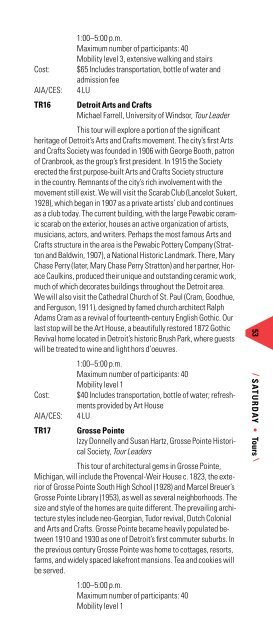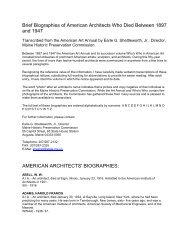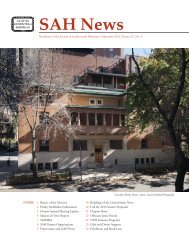Program - Society of Architectural Historians
Program - Society of Architectural Historians
Program - Society of Architectural Historians
Create successful ePaper yourself
Turn your PDF publications into a flip-book with our unique Google optimized e-Paper software.
Cost:<br />
AIA/CES:<br />
TR16<br />
1:00–5:00 p.m.<br />
Maximum number <strong>of</strong> participants: 40<br />
Mobility level 3, extensive walking and stairs<br />
$65 Includes transportation, bottle <strong>of</strong> water and<br />
admission fee<br />
4 LU<br />
Detroit Arts and Crafts<br />
Michael Farrell, University <strong>of</strong> Windsor, Tour Leader<br />
This tour will explore a portion <strong>of</strong> the significant<br />
heritage <strong>of</strong> Detroit’s Arts and Crafts movement. The city’s first Arts<br />
and Crafts <strong>Society</strong> was founded in 1906 with George Booth, patron<br />
<strong>of</strong> Cranbrook, as the group’s first president. In 1915 the <strong>Society</strong><br />
erected the first purpose-built Arts and Crafts <strong>Society</strong> structure<br />
in the country. Remnants <strong>of</strong> the city’s rich involvement with the<br />
movement still exist. We will visit the Scarab Club (Lancelot Sukert,<br />
1928), which began in 1907 as a private artists’ club and continues<br />
as a club today. The current building, with the large Pewabic ceramic<br />
scarab on the exterior, houses an active organization <strong>of</strong> artists,<br />
musicians, actors, and writers. Perhaps the most famous Arts and<br />
Crafts structure in the area is the Pewabic Pottery Company (Stratton<br />
and Baldwin, 1907), a National Historic Landmark. There, Mary<br />
Chase Perry (later, Mary Chase Perry Stratton) and her partner, Horace<br />
Caulkins, produced their unique and outstanding ceramic work,<br />
much <strong>of</strong> which decorates buildings throughout the Detroit area.<br />
We will also visit the Cathedral Church <strong>of</strong> St. Paul (Cram, Goodhue,<br />
and Ferguson, 1911), designed by famed church architect Ralph<br />
Adams Cram as a revival <strong>of</strong> fourteenth-century English Gothic. Our<br />
last stop will be the Art House, a beautifully restored 1872 Gothic<br />
Revival home located in Detroit’s historic Brush Park, where guests<br />
will be treated to wine and light hors d’oeuvres.<br />
1:00–5:00 p.m.<br />
Maximum number <strong>of</strong> participants: 40<br />
Mobility level 1<br />
Cost: $40 Includes transportation, bottle <strong>of</strong> water; refreshments<br />
provided by Art House<br />
AIA/CES: 4 LU<br />
TR17 Grosse Pointe<br />
Izzy Donnelly and Susan Hartz, Grosse Pointe Historical<br />
<strong>Society</strong>, Tour Leaders<br />
This tour <strong>of</strong> architectural gems in Grosse Pointe,<br />
Michigan, will include the Provencal-Weir House c. 1823, the exterior<br />
<strong>of</strong> Grosse Pointe South High School (1928) and Marcel Breuer’s<br />
Grosse Pointe Library (1953), as well as several neighborhoods. The<br />
size and style <strong>of</strong> the homes are quite different. The prevailing architecture<br />
styles include neo-Georgian, Tudor revival, Dutch Colonial<br />
and Arts and Crafts. Grosse Pointe became heavily populated between<br />
1910 and 1930 as one <strong>of</strong> Detroit’s first commuter suburbs. In<br />
the previous century Grosse Pointe was home to cottages, resorts,<br />
farms, and widely spaced lakefront mansions. Tea and cookies will<br />
be served.<br />
1:00–5:00 p.m.<br />
Maximum number <strong>of</strong> participants: 40<br />
Mobility level 1<br />
53 / SATURday • Tours \








